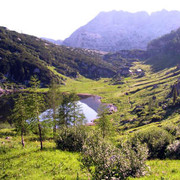Red, yellow and purple trails, 70 stages.
 Covering an area of about 84,000 km², Austria is situated right in the middle of the Alps and is one of the most diverse and culturally interesting areas. Three of a total of five Via Alpina trails with a total of 70 one-day stages lead through Austria.
Covering an area of about 84,000 km², Austria is situated right in the middle of the Alps and is one of the most diverse and culturally interesting areas. Three of a total of five Via Alpina trails with a total of 70 one-day stages lead through Austria.
These also intersect time and time again with the 10 Austrian long-distance trails and some of the European long-distance trails, which demonstrate that the Via Alpina is an integral part of a network of walking trails. No single part of the trail had to be newly built for the Via Alpina.
On three trails through Austria, the Yellow Trail, the Red Trail and the Purple Trail you will reach areas, which can only be rated as unique not only in Austria but also in the entire Alpine region. For example, the highest elevation of the Via Alpina is along the Yellow Trail at the Niederjoch at 3,019 m, located at the border of Italy and Austria in the immediate vicinity of the location where the "Ötzi", the Iceman, was found. The glacial world of the Ötztal-Alps and the Pitztal-Alps is impressive but accessible without specialist equipment.
The Red Trail at the Karnischer Kamm commemorates war events of World War I and has won great acclaim as the “Peace Trail”. The ruggedness and beauty of the protected areas in the Zillertal (Nature Park Zillertal-Alps), in Karwendel (Alpine Park Karwendel), in Lechtal (Nature Reserve Wildflusslandschaft Tiroler Lechauen – protecting wild river landscapes) as well as the Biosphere-Reserve Großes Walsertal in Vorarlberg are in no way surpassed by the mountainous landscapes of the Himalaya or the Rocky Mountains. The Alpine cities of Innsbruck and Feldkirch bear witness to centuries of history and invite you to stay a while.
The Purple Trail offers wonderful views at the Hochobir in Südkärnten, gentle hills at the Koralm meadow, the Gesäuse and Kalkalpen national parks, the largest monastic library of the world in Admont, the beautiful and in no way dead “Totes Gebirge” (“Dead Mountains”), the Cultural Heritage Region Hallstatt at the feet of the Dachstein, the ice cave “Eisriesenwelt” in Werfen and the legendary “Übergossene Alm” (Coated Alp) at the Hochkönig.
On all trails the huts provided by the Alpine associations as well as private huts offer accommodation and catering; hotels and guesthouses offer culinary specialities and comfort.
Several of the municipalities crossed are also “mountaineering villages”: for example Vent and Ginzling as well as the Tyrolean valley of Gail, the valley of Lesach and the Großes Walsertal (the great Walser valley). These municipalities are renowned for their great competence in all aspects of the Alpine environment, their authenticity and their strong Alpine history. Their offers of climbing or ski-mountaineering enrich the choice along the Via Alpina – a long stay is heartily recommended!
All interested long-distance hikers can find on the website www.wanderkompass.de a series of further attractive trails in Germany, Austria and Liechtenstein.
The Team at Via Alpina Austria looks forward to be able to greet you along one of the Austrian Trails and hopes you have a wonderful and relaxing walking holiday!


 Covering an area of about 84,000 km², Austria is situated right in the middle of the Alps and is one of the most diverse and culturally interesting areas. Three of a total of five Via Alpina trails with a total of 70 one-day stages lead through Austria.
Covering an area of about 84,000 km², Austria is situated right in the middle of the Alps and is one of the most diverse and culturally interesting areas. Three of a total of five Via Alpina trails with a total of 70 one-day stages lead through Austria.
